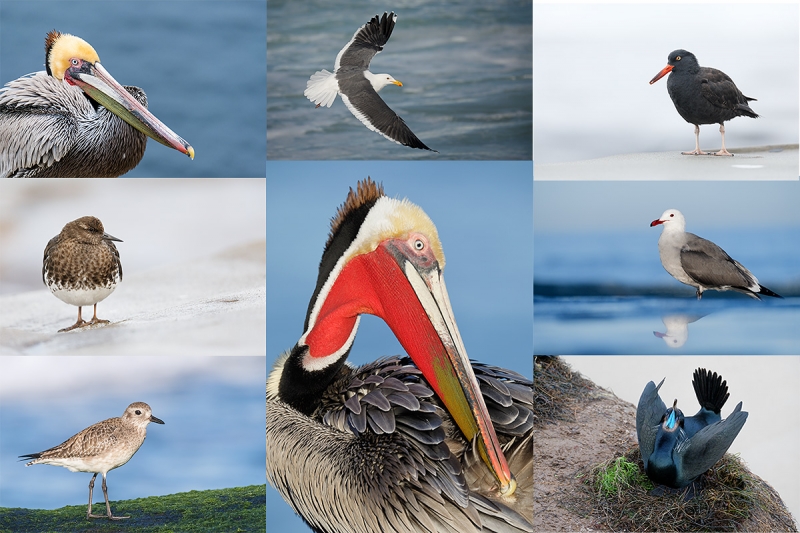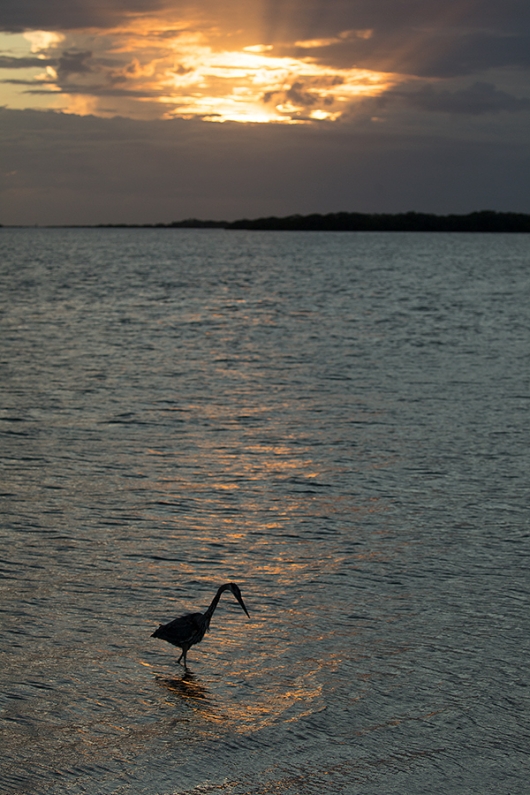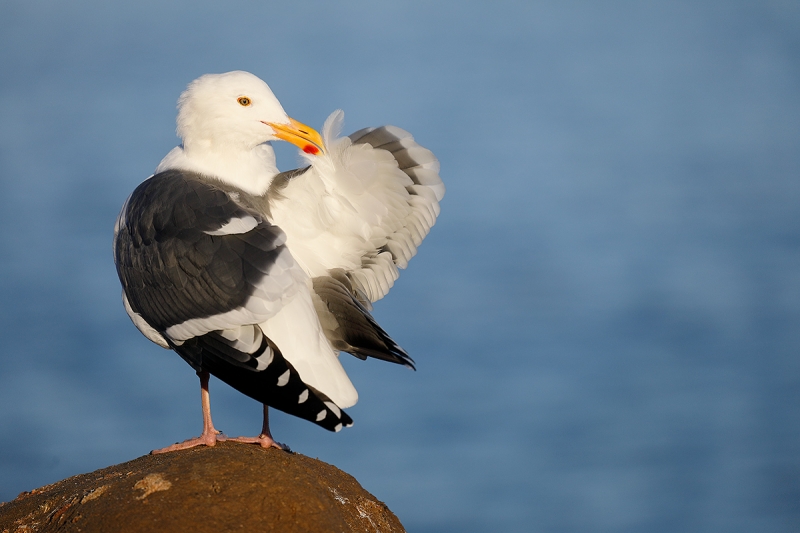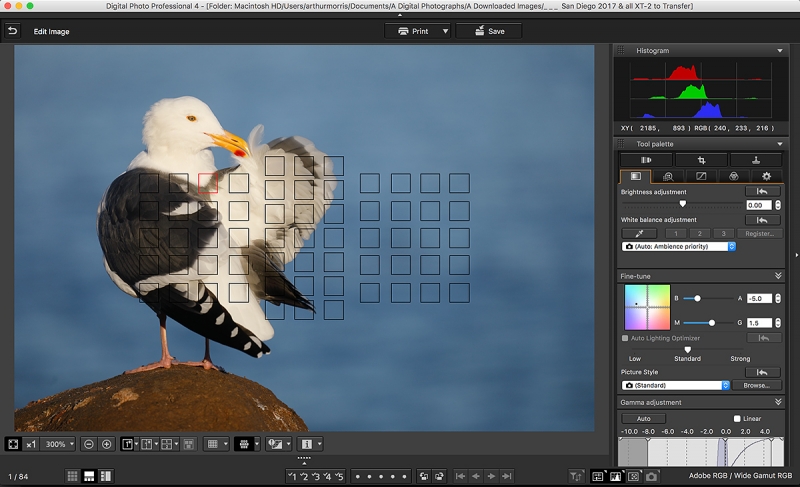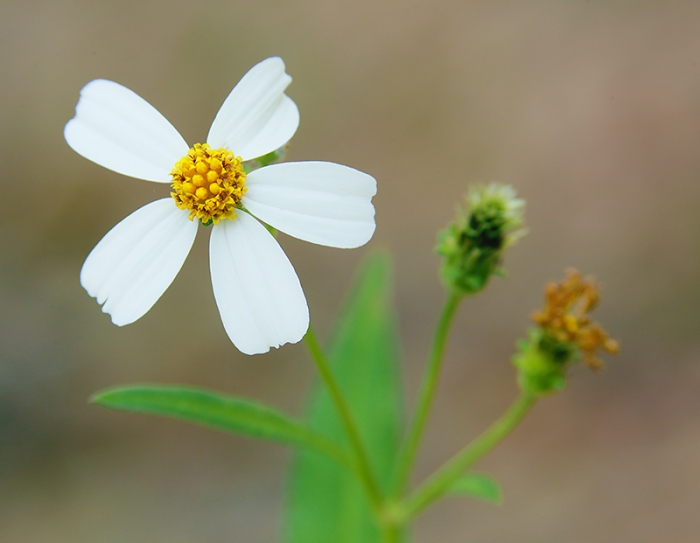October 16th, 2017 Stuff
I did enjoy a morning swim on Saturday and then made it over to DeSoto for the afternoon. I searched for the mystery heron/egret but did not find it. With a strong east wind and mostly clear skies, conditions were tough for bird photography; can you say “wind against sun?” But I really do love Desoto. And I did get to photograph a pretty neat rainbow. I ended the day at my favorite secret sunset spot and found a cooperative juvie Great Blue Heron. You can learn about my secret sunset spot in the DeSoto Site Guide. Scroll down for more info on the guide. I did stay over and photograph on Sunday morning. More on that session soon.
I am still looking for a few more folks for San Diego #2. If you are considering this trip and might be interested in adding on a free day of instruction before the IPT begins please shoot me an e-mail.
The Streak
Today makes eighty-one days in a row with a new educational blog post! This blog post took less than an hour to prepare. With all of my upcoming free time (or not …), the plan right now is to break the current record streak of (I think) four hundred eighty something … Good health and good internet connections willing.
Fort DeSoto Site Guide
Fort DeSoto is about the only bird photography hotspot that I know of that has the potential to offer great opportunities every day of the year. The big attractions are shorebirds, all the large wading birds (including Wood Stork and Roseate Spoonbill at various seasons), and many species of terns and gulls. In the spring you can usually photograph the breeding behaviors of Royal & Sandwich Terns and Laughing Gull. Flight photography can be great when a feeding spree occurs just off of the beach. These feature terns and gulls and Brown Pelican. Spring and fall migration can be excellent for all manner of warblers, vireos, gnatcatchers, tanagers, grosbeaks, and orioles in some of the wooded areas. By purchasing the guide you will know exactly where to be on what tide and what wind. Why waste your time searching for the birds when you can just show up and act like a DeSoto veteran?
Get yourself a copy of the Fort DeSoto Site Guide. Learn the best spots, where to be when in what season in what weather. Learn the best wind directions for the various locations. BAA Site Guides are the next best thing to being on an IPT. You can see all of them here.
|
|
2017 in San Diego was a very good year ….
|
2018 San Diego 3 1/2-DAY BIRDS AS ART IPT #2: Sunday, JAN 28 thru and including a morning session on Wednesday, JAN 31, 2018: 3 1/2 days: $1699. Limit: 8: Openings: 7
Meet and Greet at 6:30pm on the evening before the IPT begins; Saturday, Jan 27, 2018.
San Diego IPT #2: Shorter and Less Expensive!
Please remember: I go with one.
Click here for details.
Booking.Com
Booking.Com came through for me twice again recently with both the DeSoto Fall IPT and next July’s UK Puffins, Gannets, and Bempton Pre-trip room reservations. And all the rates were great. If you’d like to give Booking.Com a shot, click here and you will earn a $25 reward. Thanks to the many who have already tried and used this great service.


Gear Questions and Advice
Too many folks attending BAA IPTs and dozens of folks whom I see in the field, and on BPN, are–out of ignorance–using the wrong gear especially when it comes to tripods and more especially, tripod heads… Please know that I am always glad to answer your gear questions via e-mail.
|
|
|
This image was created on the late afternoon of Friday, October 13 with the hand held Canon EF 100-400mm f/4.5-5.6L IS II USM lens (at 112mm) and my favorite bird photography camera, the Canon EOS 5D Mark IV. ISO 800. Evaluative metering -2/3 stop: 1/2,000 sec. at f/6.3 in Av mode. AWB.
Center AF point/AI Servo/Expand/Rear Button AF and recompose.
FocusTune/LensAlign Micro Adjustment: -2.
Great Blue Heron sunrise scenic with god-rays.
|
My Critique
The JPEG above represents the RAW file converted straight up in ACR (with no adjustments). The image overall is way too dark because of the underexposure that was needed to hold back the bright sections of the sky … As both the bird and the god rays are a bit too centered, I wish that I had moved two steps to my right so that the bird would have been closer to the lower left corner and the god rays closer to the upper right corner. I created the image at K-7600 to juice up the colors but the underexposure muted those quite a bit. I converted the image in DPP 4 and optimized it in Photoshop. I will share it with you here in a few days.
The First-Ever RAW File/Image Optimization Challenge
If you would like to take a crack at this image please click here to download the RAW file. Save the image to your hard drive, convert it in the program of your choice, and then optimize it with the program of your choice. save the TIF. Then create a sharpened 900 pixel tall JPEG and shoot it to me via e-mail.
Assuming that I receive at least a few decent images, I will publish at least the best one here on Friday along with my optimized version.
If at least a few folks give it a try, we can play this game again. If not — well, you can figure it out. Those who try will wind up learning a ton. And who knows, they may create an image that is stronger than mine 🙂
More 100-400 II Versatility
Note here that I used the hand held Canon EF 100-400mm f/4.5-5.6L IS II USM lens at the wide end to create a scenic (without having to run back to the car for a shorter lens). The focal length range (with or without the Canon Extender EF 1.4X III), its relatively light weight, and its amazing close focus (down to less than one meter) make this the most versatile lens you will ever own. In addition, it is quite an excellent flight lens; being able to zoom out on close-flying pelicans and gulls can be a huge plus. Lastly, as we saw the other day, you can add a few extension tubes and use the 1-4II to photograph very small flowers.
If In Doubt …
If in doubt about using the BAA B&H affiliate link correctly, you can always start your search by clicking here. Please note that the tracking is invisible. Web orders only. Please, however, remember to shoot me your receipt via e-mail.




Please Remember to use my Affiliate Links and to Visit the New BAA Online Store 🙂
To show your appreciation for my continuing efforts here, we ask, as always, that you get in the habit of using my B&H affiliate links on the right side of the blog for all of your photo and electronics purchases. Please check the availability of all photographic accessories in the New BIRDS AS ART Online Store, especially the Mongoose M3.6 tripod head, Wimberley lens plates, Delkin flash cards and accessories, and LensCoat stuff.
As always, we sell only what I have used, have tested, and can depend on. We will not sell you junk. We know what you need to make creating great images easy and fun. And please remember that I am always glad to answer your gear questions via e-mail.
I would of course appreciate your using our B&H affiliate links for all of your major gear, video, and electronic purchases. For the photographic stuff mentioned in the paragraph above, and for everything else in the new store, we, meaning BAA, would of course greatly appreciate your business. Here is a huge thank you to the many who have been using our links on a regular basis and those who will be visiting the New BIRDS AS ART Online Store as well.
Amazon.com
Those who prefer to support BAA by shopping with Amazon may use the logo link above.
Amazon Canada
Many kind folks from north of the border, eh, have e-mailed stating that they would love to help us out by using one of our affiliate links but that living in Canada and doing so presents numerous problems. Now, they can help us out by using our Amazon Canada affiliate link by starting their searches by clicking here.
Facebook
Be sure to like and follow BAA on Facebook by clicking on the logo link upper right. Tanks a stack.
Typos
In all blog posts and Bulletins, feel free to e-mail or to leave a comment regarding any typos or errors. Just be right :).
October 15th, 2017 Stuff
It was 8:12am on Saturday morning as I put the finishing touches on this blog post. I am toying with the idea of heading over to Fort DeSoto this afternoon to look for the mystery heron/egret. I would stay over on Saturday night. I will need to swim early today and start driving at about lunch time …
I am still looking for a few more folks for San Diego #2. If you are considering this trip and might be interested in adding on a free day of instruction before the IPT begins please shoot me an e-mail.
The Streak
Today makes eighty days in a row with a new educational blog post! This blog post took less than an hour to prepare. With all of my upcoming free time (or not …), the plan right now is to break the current record streak of (I think) four hundred eighty something … Good health and good internet connections willing.
|
|
2017 in San Diego was a very good year ….
|
2018 San Diego 3 1/2-DAY BIRDS AS ART IPT #2: Sunday, JAN 28 thru and including a morning session on Wednesday, JAN 31, 2018: 3 1/2 days: $1699. Limit: 8: Openings: 7
Meet and Greet at 6:30pm on the evening before the IPT begins; Saturday, Jan 27, 2018.
San Diego IPT #2: Shorter and Less Expensive!
Please remember: I go with one.
Click here for details.
Booking.Com
Booking.Com came through for me twice again recently with both the DeSoto Fall IPT and next July’s UK Puffins, Gannets, and Bempton Pre-trip room reservations. And all the rates were great. If you’d like to give Booking.Com a shot, click here and you will earn a $25 reward. Thanks to the many who have already tried and used this great service.


Gear Questions and Advice
Too many folks attending BAA IPTs and dozens of folks whom I see in the field, and on BPN, are–out of ignorance–using the wrong gear especially when it comes to tripods and more especially, tripod heads… Please know that I am always glad to answer your gear questions via e-mail.
|
|
|
This image was created on the 2017 San Diego IPT with the hand held Canon EF 100-400mm f/4.5-5.6L IS II USM lens (at 360mm) and my favorite bird photography camera, the Canon EOS 5D Mark IV. ISO 400. Evaluative metering probably at zero as famed: 1/2000 sec. at f/6.3 in Manual mode. AWB.
One AF point that was two and one-half rows up from and three columns to the right of the center AF point/AI Servo/Manual selection/Shutter Button AF as framed was active at the moment of exposure. See the DPP 4 screen capture below to see the exact placement of the single (selected) AF point.
FocusTune/LensAlign Micro Adjustment: 0.
Western Gull, adult breeding plumage preening
|
Helpful Bird Photography Principles …
- 1- When photographing a bird from behind the best head angle will generally be very close to a perfect 90 degrees with the bird’s head square or close to square to the imaging sensor.
- 2- When photographing a bird from behind be sure to focus on or very near the head.
- 3- When working in horizontal format be sure to select your AF point carefully so as to keep the bird out of the center of the frame (unless you can verbalize a very good reason for putting the subject dead center …)
- 4- Learn to work competently in Manual mode so that the amount of black or white in the frame at a given moment will not affect the exposure. That involves making an exposure check image, checking or blinkies, and evaluating the histogram to make sure that you have exposed well to the right (with at least some data halfway into the rightmost histogram box).
- 5- Even when photographing a bird from behind there is no need to use additional depth of field as long as the distance to the subject provides you will enough depth of field to cover the subject (as with today’s featured image).
- 6- Working with backgrounds that are separated from the subject and relatively distant while using wide apertures will yield pleasingly out of focus canvases for your avian images.
From Chapter Seven, Designing the Image (page 108), of the original The Art of Bird Photography (Amphoto, NY: 1998)
If the subject is positioned against an uncluttered background or if there is a cluttered background well behind the subject, telephoto lenses — with their narrow angles of view — and the shallow depth of field that comes with the use of wide apertures, will produce lovely soft, out-of-focus backgrounds. I’ll take still blue water or well lit green foliage every time.
Shooting wide open (at your lens’ widest aperture heightens this effect; with subject size constant, it is the aperture rather than the length of the lens that determines the depth of field. Large apertures such as f/2.8, f/4, and f/5.6, minimize depth of field and reduce background detail. Conversely, small apertures, such as f/16 and f/22, maximize depth of field and increase background detail.
Note: I changed a single word in the second paragraph above to improve the clarity of the writing.
More 100-400 II Versatility
The hand held Canon EF 100-400mm f/4.5-5.6L IS II USM lens is deadly on the cliffs of La Jolla with or without the Canon Extender EF 1.4X III. Its focal length range, its relatively light weight, and its amazing close focus (down to less than one meter) make it my most valuable lens when visiting San Diego. In addition, it is quite an excellent flight lens and being able to zoom out on close-flying pelicans and gulls can save the day.
|
|
The DPP 4 Screen Capture for today’s featured image
|
Understanding the Color of Light/Part I
Note the RGB values for the brightest WHITEs: R=240, G = 233, B = 216. Not the high value for RED and the low value for B despite the fact that I moved the Color fine tune dot toward BLUE. Note also that this image was created at 7:39am. On clear mornings not long after sunrise the light is rich in REDs and YELLOWs; much of the BLUE is filtered out as the light travels obliquely a long way through the earth’s atmosphere. The result is what we call “early” or “sweet” light (as opposed to the colder light later on in the day when the sun is much more directly overhead. As a guideline folks often state that the really “sweet” light occurs on clear days when your shadow is three time longer than your height. I am generally fine with twice my height. Note that the lower the sun in the sky the more comfortable I am working a bit off sun angle.
As I like the look of the rich, warm light in this image I was not at all concerned with having the WHITEs completely neutral, say 235, 235, 235. I could have worked toward that end if I wanted to either during the RAW conversion in DPP 4 or during the image optimization in Photoshop. But I am a firm believer in “if it ain’t broke, don’t fix it.”
The Lesson
There is no need to work towards having perfectly neutral WHITEs or a perfectly neutral White Balance if you are happy with the colors in an image.
High-Level AF Point Selection Question
Why did I abandon my usual AF Expand for this particular situation and go with Manual selection (i.e., with a single AF point)?
If In Doubt …
If in doubt about using the BAA B&H affiliate link correctly, you can always start your search by clicking here. Please note that the tracking is invisible. Web orders only. Please, however, remember to shoot me your receipt via e-mail.




Please Remember to use my Affiliate Links and to Visit the New BAA Online Store 🙂
To show your appreciation for my continuing efforts here, we ask, as always, that you get in the habit of using my B&H affiliate links on the right side of the blog for all of your photo and electronics purchases. Please check the availability of all photographic accessories in the New BIRDS AS ART Online Store, especially the Mongoose M3.6 tripod head, Wimberley lens plates, Delkin flash cards and accessories, and LensCoat stuff.
As always, we sell only what I have used, have tested, and can depend on. We will not sell you junk. We know what you need to make creating great images easy and fun. And please remember that I am always glad to answer your gear questions via e-mail.
I would of course appreciate your using our B&H affiliate links for all of your major gear, video, and electronic purchases. For the photographic stuff mentioned in the paragraph above, and for everything else in the new store, we, meaning BAA, would of course greatly appreciate your business. Here is a huge thank you to the many who have been using our links on a regular basis and those who will be visiting the New BIRDS AS ART Online Store as well.
Amazon.com
Those who prefer to support BAA by shopping with Amazon may use the logo link above.
Amazon Canada
Many kind folks from north of the border, eh, have e-mailed stating that they would love to help us out by using one of our affiliate links but that living in Canada and doing so presents numerous problems. Now, they can help us out by using our Amazon Canada affiliate link by starting their searches by clicking here.
Facebook
Be sure to like and follow BAA on Facebook by clicking on the logo link upper right. Tanks a stack.
Typos
In all blog posts and Bulletins, feel free to e-mail or to leave a comment regarding any typos or errors. Just be right :).
October 14th, 2017 Stuff
I finished watching both Thursday games on Tivo on Friday the morning. The Cubs beat the still hapless Nats in a crazy game in which an umpiring error led directly to several Cubs runs and the loss of the game. The Panthers had many chances to beat the Eagles but simply did not come through. I worked on several blog posts and began reviewing a book for a friend. I swam a full mile in one sitting at midday; I started in a full downpour and ended in bright sun.
I am still looking for a few more folks for San Diego #2. If you are considering this trip and might be interested in adding on a free day of instruction before the IPT begins please shoot me an e-mail.
The Streak
Today makes seventy-nine days in a row with a new educational blog post! This blog post took less than an hour to prepare. With all of my upcoming free time (or not …), the plan right now is to break the current record streak of (I think) four hundred eighty something … Good health and good internet connections willing.
|
|
2017 in San Diego was a very good year ….
|
2018 San Diego 3 1/2-DAY BIRDS AS ART IPT #2: Sunday, JAN 28 thru and including a morning session on Wednesday, JAN 31, 2018: 3 1/2 days: $1699. Limit: 8: Openings: 7
Meet and Greet at 6:30pm on the evening before the IPT begins; Saturday, Jan 27, 2018.
San Diego IPT #2: Shorter and Less Expensive!
Please remember: I go with one.
Click here for details.
Booking.Com
Booking.Com came through for me twice again recently with both the DeSoto Fall IPT and next July’s UK Puffins, Gannets, and Bempton Pre-trip room reservations. And all the rates were great. If you’d like to give Booking.Com a shot, click here and you will earn a $25 reward. Thanks to the many who have already tried and used this great service.


Gear Questions and Advice
Too many folks attending BAA IPTs and dozens of folks whom I see in the field, and on BPN, are–out of ignorance–using the wrong gear especially when it comes to tripods and more especially, tripod heads… Please know that I am always glad to answer your gear questions via e-mail.
Kenko Extension Tube Set DG for Canon EOS Lenses
In the What Lens and Accessories? blog post here two weeks ago I posted:
You Tell Me …
Take a close look at the image caption above and then make an educated guess and let me know what lens, what focal length, and what accessory or accessories you think I used to create today’s featured image of a relatively small (3/4 inch) flower. Trust me, there is a clue, at least to the lens used. After that, you might be able to figure the rest out. But it won’t be easy.
The Somewhat Strange Answer …
While there were some good guesses, nobody came up with my work-around. Two folks got the lens right; I used the obviously amazingly versatile Canon EF 100-400mm f/4.5-5.6L IS II USM lens with the Canon Extender EF 1.4X III. The clue to the lens/TC combo was the f/9 aperture. As noted above, the rest of the rig consisted of all three extension tubes in the Kenko Auto Extension Tube Set DG for Canon EOS lenses,, and my favorite flower photography body, the Canon EOS 5D Mark IV.
Extension Tube Basics
Extension tubes are primarily used so that you can get closer to the subject than the minimum focusing distance of the lens normally allows. They are often used with various macro lenses. I began using them with telephoto lenses more than thirty years ago with my Canon FD 400mm f/4.5 (manual focus) lens. Once I started crawling in the mud to get close to shorebirds I found that it was easy to get within nine or ten feet of the birds using the super low approach. The problem was that the lens only focused down to 12 feet. Once I added an FD 25mm extension tube, I was able to focus to less than ten feet and easily fill 3/4 of the frame with a Least Sandpiper. Do understand that once you add an extension tube to the mix that you will not be able to focus on relatively distant subjects. I almost forgot to mention that if you are outside of the lens’s MFD, an extension tube can be used to increase the size of the subject in the frame; they can actually serve as mini-teleconverters.
As the decades progressed, I wound up using both the EF 12mm and the EF 25mm Canon Extension tubes with all of my telephoto lenses up to and including the old 800mm f/5.6L IS. Over the past few years I have not often needed to add an extension tube as the newer telephoto lenses have such remarkable minimum focusing distances; the 600 II focuses down to less than 15 feet, the 500 II to 12.14 feet, and the 100-400 II down to an amazing 3.2 feet. The latter MFD gives the 100-400 the greatest magnification of any Canon telephoto lens: .31X.
Today, I always travel with two EF 12mm Extension Tubes. While I use them on occasion for closer focusing, their main function is to serve as a spacer so that I can stack my 1.4X III TCs with my 2X III TCs. I usually travel with at least two of each TC.
Canon or Kenko Extension Tubes?
The Canon EF 12mm Extension Tube sells for $82.00. The Canon EF 25mm Extension Tube sells for $139.95. The Kenko Auto Extension Tube Set DG for Canon EOS lenses consists of three extension tubes, a 12mm, a 20mm, and a 36mm. All autofocus and metering functions remain functional. When you first use the Kenko tubes you will likely find the fit snugger than with the Canon tubes. This takes a bit of getting used to but is actually a plus as the Canon lens mounts often get sloppy over time. Oh, the good news, the Kenko set costs $109.00.
Which are sharper, the Canon tubes or the Kenko tubes? Neither. Extension tubes are hollow and do not affect sharpness in any way. Do remember to stop down some when using extension tubes to prevent vignetting.
Nikon Extension Tubes
For decades Nikon did not offer any extension tubes. I knew several Nikon pros who were so frustrated by this that they ripped the guts out of their Nikon TCE 14 teleconverters so that they could use them as extension tubes. Nikon now offers three extension tubes as follows:
Nikon 8mm AI Extension Tube PK-11A
Nikon 14mm AI Extension Tube PK-12
Nikon PK-13 27.5mm AI Extension Tube
Amazingly, none of the Nikon tubes support autofocus …
The Kenko Auto Extension Tube Set DG (12, 20 & 36mm Tubes) for Nikon Digital and Film Cameras
Amazingly, the Kenko Auto Extension Tube Set DG (12, 20 & 36mm Tubes) for Nikon Digital and Film Cameras offers both functional metering and functional autofocus as noted here:
The Kenko Auto Extension Tube Set DG is compatible with Nikon DSLR cameras and F mount lenses and is optimized to work with Autofocus lenses. Kenko’s Auto Focus extension tubes are designed with all the circuitry and mechanical coupling to maintain auto focus and TTL auto exposure with most Nikon lenses given there is enough light (at f/5.6 or brighter) to activate the cameras AF system properly.
Owning a set of these completely Nikon compatible extension tubes would be a huge plus for all Nikon folks.
Extension Tube Questions …
If you have a question about extension tubes you are invited to leave a comment to that effect.
If In Doubt …
If in doubt about using the BAA B&H affiliate link correctly, you can always start your search by clicking here. Please note that the tracking is invisible. Web orders only. Please, however, remember to shoot me your receipt via e-mail.




Please Remember to use my Affiliate Links and to Visit the New BAA Online Store 🙂
To show your appreciation for my continuing efforts here, we ask, as always, that you get in the habit of using my B&H affiliate links on the right side of the blog for all of your photo and electronics purchases. Please check the availability of all photographic accessories in the New BIRDS AS ART Online Store, especially the Mongoose M3.6 tripod head, Wimberley lens plates, Delkin flash cards and accessories, and LensCoat stuff.
As always, we sell only what I have used, have tested, and can depend on. We will not sell you junk. We know what you need to make creating great images easy and fun. And please remember that I am always glad to answer your gear questions via e-mail.
I would of course appreciate your using our B&H affiliate links for all of your major gear, video, and electronic purchases. For the photographic stuff mentioned in the paragraph above, and for everything else in the new store, we, meaning BAA, would of course greatly appreciate your business. Here is a huge thank you to the many who have been using our links on a regular basis and those who will be visiting the New BIRDS AS ART Online Store as well.
Amazon.com
Those who prefer to support BAA by shopping with Amazon may use the logo link above.
Amazon Canada
Many kind folks from north of the border, eh, have e-mailed stating that they would love to help us out by using one of our affiliate links but that living in Canada and doing so presents numerous problems. Now, they can help us out by using our Amazon Canada affiliate link by starting their searches by clicking here.
Facebook
Be sure to like and follow BAA on Facebook by clicking on the logo link upper right. Tanks a stack.
Typos
In all blog posts and Bulletins, feel free to e-mail or to leave a comment regarding any typos or errors. Just be right :).
|
|







